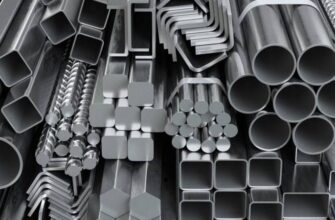The use of bimetals and multilayer materials in machine-building structures is increasing every year., combining strength, inadequacy, low cost of the main structural layer and special properties of a thin coating - corrosion and cavitation resistance, antifriction, electrical conductivity, etc.. Besides, bimetals can be used as structural elements, as adapters for connecting parts made of dissimilar metals and alloys.
Explosion welding is one of the promising ways to obtain bimetals.. The essence of the process is as follows: under the action of high pressure of the expanding explosion products, the projected plate acquires a speed of the order of several hundred meters per second and collides with the stationary plate at a certain angle; due to high collision velocities and pressure in the contact zone, the surfaces are cleaned, their activation and formation of a compound in the solid phase.
The main advantages of explosion welding over other welding and cladding methods include:
- the ability to connect almost any metal, including difficult to connect and not connected by conventional methods;
- high productivity of the process when cladding large-sized items in comparison with surfacing and casting;
- short duration and ease of implementation of the process;
- obtaining uniform cladding layers of almost any thickness due to the use of high-quality sheet metal.
As is known, aluminum alloys are widely used in shipbuilding. Despite their higher cost compared to steel, ship structures made of aluminum alloys pay off faster due to a number of advantages: lightness, nonmagnetism, corrosion resistance and sufficiently high strength. All-aluminum structures are manufactured, usually by welding; the connection of aluminum parts to steel can be done by riveting or welding, through bimetallic transition elements. Welding, naturally, less labor-intensive process compared to riveting. Besides, the resulting connections are more reliable.
The technology of welding aluminum alloys with steel using bimetallic adapters has been introduced, eg, for connecting the bulkheads of the superstructure to the steel deck of the ship. Bimetal for adapters can be obtained both by rolling, and by explosion welding. However, the possibilities of rolling are limited when receiving adapters with a thickness of bimetal components greater than 5 mm, as well as having significant dimensions in area.
Currently bimetallic adapters, explosion welded, are increasingly used abroad.
In Poland, at the Gdansk shipyard, several vessels were built using just such intermediate elements (steel + aluminum alloy). Adapters were cut from three-layer sheets: shipbuilding steel (thickness 20 mm) + under a layer of pure aluminum (6 mm) + aluminum-magnesium alloy (10 mm). celebrated, what adapters, explosion welded, characterized by high corrosion resistance and strength properties.
In Yugoslavia, a ship was built at the Split shipyard for Finland, in which bimetal strips are used to connect the aluminum superstructure to the steel deck: steel (20 mm) + pure aluminum (6-10 mm) + aluminum-magnesium alloy (5-8 mm). Explosion-welded joints have high strength under static and cyclic loads. According to work, during the construction of a destroyer using bimetallic transition elements, the mass of the hull due to the use of superstructures made of aluminum alloys was reduced by 100 t.
If necessary, by explosion welding, other compositions for the manufacture of transition elements can be obtained. (steel + titanium, titanium + aluminum, etc.). By means of bimetal it is possible to connect not only sheets, but also pipes, made of dissimilar materials. In this case, ring transition elements are obtained from a bimetallic blank by machining or stamping..
Besides, there are other promising areas of application of bimetals. So, The paper analyzes the potential advantages of building large and small ships using steel sheets as cladding, clad with copper-nickel alloy, having antifouling properties. The economic effect is due to a decrease in fuel consumption, increasing the operational speed of the vessel, increase in overhaul periods, saving money on body painting.
Other applications of explosion welding in shipbuilding and ship repair should also be considered.. In order to save scarce materials, it is advisable, eg, bimetal (steel + stainless steel or steel + aluminum) vessel storage tanks for fresh water. Replacing all-metal parts with bimetallic ones can serve as a big reserve for saving non-ferrous metals.. So, operating conditions of liners and bushings in friction units of ship mechanisms allow them to be performed in two layers - with a steel base and an internal thin antifriction layer of bronze or brass. Explosion welding is the most suitable method for making such two-layer products., providing uniformity and high strength of cladding, no casting defects and the need for large allowances for subsequent machining.
Parts and assemblies, working in conditions of intense impact or shock-abrasive wear, predominantly hardened by surfacing Hadfield wear-resistant steel. Often poor weld metal quality (chemical and structural heterogeneity, scattering, etc.), high labor intensity and energy consumption significantly reduce the efficiency of this technological process. In this regard, the use of a bimetallic composition is very promising.: low-carbon steel + steel 110G13. In this case, a well-welded low-carbon steel with a thickness of 4-6 mm, blast-welded onto Hadfield wear-resistant steel, serves as a transition layer for welding the part to the supporting structure. Such a bimetal is successfully used at the enterprises of the Ministry of River Fleet for the skids of the carriage of the scoop of the dredger..
Considering the significant volumes of machining at enterprises and the shortage of tool materials, obviously, it is advisable to introduce bimetallic tools. Flat broaches made of bimetal, tangential and prismatic cutters, punching dies, in which only the cutting part is made of tool steel, allow you to save, eg, to 80% tungsten materials. Durability of bimetal tools, produced by explosion welding, is at the level, corresponding to the durability of serial all-metal tools.
As for the main mechanical properties of such bimetals, then they correspond approximately to the level of properties of similar bimetals, obtained by the most common method - batch rolling. The bond strength of the layers during explosion welding is on average 30% above. Performance properties of bimetals (corrosion resistance, wear resistance, antifriction, etc.) correspond to the properties of the cladding layer.
In conclusion, the prospects for the use of bimetals in shipbuilding and ship repair can be illustrated by the following examples.
Carbon steel + stainless steel. Applications - tanks for storage and transportation of water, tanks, etc.. d. Economic, technical and other efficiency ^: increased corrosion resistance, saving stainless steel, weight loss.
Steel + aluminum (Aluminium alloy). Adapters for connecting superstructures to the deck, capacity. Replacement of riveted joints with welded ones, reduction of labor intensity during repair, weight reduction, increased corrosion resistance.
Steel + bronze. Friction units and plain bearings. Saving non-ferrous metals, increase in bearing capacity and cyclic strength.
Steel + copper-nickel. Hull. No fouling of the body and, as a consequence, a decrease in fuel consumption, increasing the operational speed of the vessel and increasing the overhaul periods.
Steel St3 + steel 110G13. Slides of carriages of scoops of dredgers, etc.. P. Increased reliability and, Consequently, increase in overhaul periods.
Structural steel + tool steel. Metalworking tool. Saving scarce materials, increased cyclic strength.







